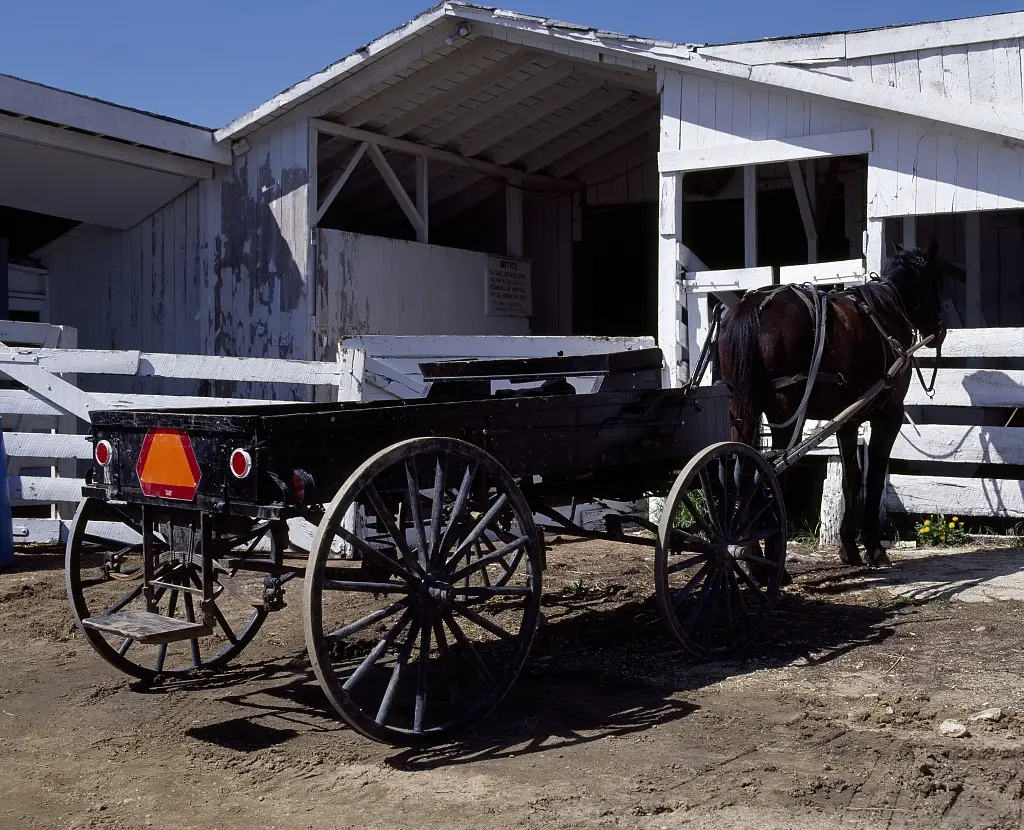Why Do Amish Women Wear Bonnets

The Amish are a religious group who live a traditional lifestyle that has remained largely unchanged for centuries. A key part of their culture is the distinctive clothing they wear, particularly the bonnets worn by Amish women. These bonnets have been an integral part of Amish dress since the early days of the faith and continue to be an important part of their identity today. There are several reasons why Amish women wear bonnets, including modesty, tradition, and symbolism.Amish women wear bonnets as a way to display their faith and devotion to the Amish religion. The bonnet is a symbol of humility and submission to God. Additionally, the bonnet is seen as a way for the Amish woman to cover her hair in accordance with the Bible. The bonnets are typically made with very simple fabrics and designs, further emphasizing the need for modesty and simplicity in Amish culture.
The Amish Beliefs Behind Wearing Bonnets
The Amish have held on to their traditional beliefs and practices for centuries, and one of the most iconic symbols of their culture is the bonnet. Wearing bonnets is an important part of Amish life, and it has both religious and practical purposes.
In the Amish faith, women are expected to keep their hair covered in public at all times. This is based on biblical passages such as 1 Corinthians 11:15 which state that women should cover their heads when they pray or prophesy. The bonnet serves as a reminder for women to remember their modesty and humility before God.
Bonnets also serve a practical purpose for the Amish. They protect women’s hair from getting dusty or wet while they are working in the fields or outdoors. In addition, the bonnets also provide protection from the sun’s harmful rays, which can be especially important during hot summer days.
The style of the bonnet varies depending on an individual’s preference. Some Amish women prefer to wear a traditional black bonnet while others choose to wear more colorful ones with ribbons or other decorations. Regardless of style, wearing a bonnet is an important part of Amish culture that shows respect for their faith and values.
Apart from being a religious symbol, wearing a bonnet has also come to represent certain aspects of Amish life such as thriftiness and hard work. The idea is that by covering up one’s hair with a simple head covering, one can focus more on important matters such as family, faith, and work instead of worrying about physical appearance or material possessions.
In today’s world where materialism reigns supreme, it can be refreshing to see how some cultures still value simplicity and modesty above all else. The Amish are known for living out these values in their everyday lives through their traditions and practices such as wearing bonnets as a sign of respect for God and humility before others.
The Practical Side to Wearing a Bonnet
Bonnets have been around for many years and are still popular today. They are a great way to keep your hair in place while also keeping you warm during the winter months. But there is more to wearing a bonnet than just looking fashionable. There are several practical aspects to consider as well.
One of the practical benefits of wearing a bonnet is that it can help protect your hair from the elements. In cold climates, a bonnet can provide some extra warmth for your head and scalp, which can help prevent damage from frostbite or other extreme conditions. In hot climates, a bonnet can provide some shade from the sun and help protect your hair from UV rays.
A bonnet can also be used to keep your hairstyle intact throughout the day. If you’re someone who spends time outdoors or works in a windy environment, it can be difficult to keep your hair looking neat and tidy without some kind of head covering. A bonnet can help make sure that your style stays put throughout the day no matter what activities you get up to.
Finally, wearing a bonnet can add an extra layer of protection against dirt, dust, and other debris that might otherwise get into your hair during daily activities such as gardening or working outdoors. This is especially beneficial if you have long hair as it offers an extra layer of defense against dirt and grime that might otherwise build up over time and cause damage to your strands.
Overall, there is much more to wearing a bonnet than just looking fashionable – there are plenty of practical benefits as well. From providing extra warmth in cold climates to keeping hairstyles in check throughout the day, any type of head covering has its advantages when it comes to protecting both you and your hair.
How Amish Women Style Their Bonnets
Amish women style their bonnets in a traditional way that reflects their religious faith and cultural heritage. The traditional bonnet is made of a lightweight cotton or linen fabric and is designed to be worn over the head, covering the hair. The bonnet also has a flap in the back, which can be adjusted to fit snugly around the neck. The traditional Amish bonnet also has an opening at the front, allowing for access to the hair.
The Amish woman’s bonnet is usually decorated with ribbons or lace, and sometimes flowers are added for an extra touch of femininity. Many Amish women also choose to wear ribbons around their necks as part of their traditional dress code. Bonnets come in various colors and styles, depending on personal preference and regional customs. For example, some areas may favor a certain color or type of fabric for their bonnets, while other areas may prefer a different style.
Bonnets are not only an important part of traditional Amish dress but they also serve a practical purpose. They protect the hair from dust and debris while keeping it neat and tidy underneath. Additionally, they can help keep women’s hair out of their faces when working outside in hot weather.
Bonnets are often made by hand at home by an experienced seamstress or tailor using techniques passed down through generations of Amish women. This adds another layer of meaning to these traditional garments as each one is unique and special to its wearer.
The traditional style of Amish bonnet is still worn by many women today as a sign of respect for their religion and culture, as well as for practical purposes such as keeping hair out of the face while working outdoors in hot weather.
The Significance of Different Colors of Bonnets
Bonnets are a common accessory for women and have been around for centuries. The colors of bonnets can be used to signify different meanings in different cultures. In some cultures, the color of a bonnet can indicate marital status, while in others it may signify religious affiliation or social class. In many parts of the world, colors are also used to express emotions such as joy or sorrow.
In traditional European cultures, brides often wore white bonnets to symbolize purity and innocence. Black bonnets were also popular among married women and were seen as a sign of respectability and maturity. Blue bonnets were typically worn by unmarried women who wanted to show their availability for marriage or courtship. Red bonnets were often used to indicate mourning or sadness, while yellow and green bonnets were usually associated with joy and celebration.
In some Asian cultures, the color of a woman’s bonnet can be an indication of her social status or religious affiliation. In India, Hindu women often wear bright red bonnets as part of their wedding attire; this is said to bring good fortune in marriage. Meanwhile in China, the color red is associated with prosperity and good luck; therefore red bonnets are commonly worn during festivals and special occasions such as weddings.
Different colors of bonnets have also been known to signify other meanings in various cultures around the world. For example, in Native American culture, yellow represents friendship and peace while green signifies growth and fertility; these colors are often seen on traditional tribal headwear such as warbonnets or headbands made from feathers or beads. Similarly, in some African cultures blue is believed to bring luck while purple is associated with royalty; these colors can be seen on many traditional African headwear items such as turbans or hijabs.
The significance behind different colors of bonnets has evolved over time but still remains an important part of many cultural identities around the world today. From bridal gowns to tribal headwear, the colors used in these garments carry a special meaning which serves to honor tradition and celebrate life’s special moments.

How Amish Girls Decide When to Start Wearing a Bonnet
Amish girls decide when to start wearing a bonnet as part of their commitment to their faith. Bonnets are an important part of the dress code for the Amish and are worn by all women once they reach a certain age. The exact age differs between families, but typically Amish girls begin wearing a bonnet around the age of 16 or 17. This is seen as a sign of maturity and readiness to accept the rules and regulations of the Amish faith.
Bonnets come in many different styles, colors, and materials, but all are typically designed with practicality in mind. They offer shade from the sun, protection from rain, and help keep hair tidy. The bonnet is also seen as a symbol of modesty within the Amish faith, representing humility before God and respect for one another. It is not uncommon for an Amish girl to take pride in her bonnet or have her own personal style when it comes to the type she wears.
The decision of when an Amish girl should start wearing a bonnet is usually left up to her family and community. Each family may have their own rules regarding this matter so it is important for parents to discuss this with their daughter before she begins wearing one. Some families might require that their daughter wear one at all times while others might only require that she wear it for religious services or during special occasions. Regardless of the family’s preference, most agree that it should be done with respect and in accordance with the guidelines set forth by their faith.
The decision of when an Amish girl should start wearing a bonnet is ultimately up to her family but should be done with respect for her faith. Once she reaches an appropriate age according to her family’s standards, she will begin wearing a bonnet which will represent both her maturity and commitment to her faith.
What the Bible Says About Wearing Head Coverings
The Bible mentions head coverings in several passages, but what it says can be interpreted in different ways. In 1 Corinthians 11:4-6, Paul writes that women should cover their heads in public worship. This is seen as a sign of respect to God and a sign of submission to their husbands. He also mentions that men should not have long hair, as this is considered a disgrace. Some interpretations say this passage is referring to cultural norms of the time and does not apply to modern times.
In 1 Corinthians 11:10, Paul states that every man should have a covering when he prays or prophesies. This could mean that men should wear hats or some other type of head covering when they pray or preach. Again, there are varying interpretations of this passage. Some believe that it was meant to apply only during the time period mentioned in the Bible and does not have relevance today.
In Genesis 24:65 Rebekah puts her veil on her face when she meets Isaac for the first time and it is seen as an act of respect. This could be interpreted as an example of how women should cover their heads in public and out of respect for God and their husbands.
The Bible does not give any specific instructions about wearing head coverings today, so it’s up to each individual to decide what they believe is right. Some believe head coverings are still relevant today while others do not see them as necessary anymore. Ultimately, everyone must make their own decision based on their own understanding of scripture and faith journey.
What the Ordnung Says About Bonnets and Head Coverings
The Old Order Amish follow a set of written and unwritten rules called the Ordnung, which governs many aspects of their lives. One of these rules is that women must wear a bonnet or some type of head covering when outside the home. This rule is based on Biblical teachings and is intended to remind Amish women of their modesty and humility before God. The bonnet must be plain in design, without any adornments or decorations. Furthermore, it should be black or navy blue and worn with a black scarf.
The Ordnung also requires that unmarried Amish women wear a white prayer covering while in church or participating in religious services. This prayer covering is usually made from stiffened white linen or muslin fabric and is tied under the chin with ribbons. The purpose of this covering is to maintain modesty during worship services, as well as to symbolize submission to God and faithfulness to Him.
Bonnets and head coverings are an important part of Amish culture, not only because they are required by the Ordnung but also because they help to distinguish the Amish from other communities. In addition, wearing a bonnet serves as a daily reminder for Amish women to live up to their faith’s teachings of modesty, humility, and obedience to God.

Conclusion
The Amish bonnet is a symbol of modesty and humility in the Amish community. It is a reminder of Amish values, faith, and way of life. The bonnet also serves as a physical sign of commitment to the faith and a reminder of the importance of modesty and humility. The Amish believe that wearing a bonnet reflects an attitude of submission to God’s will and helps to protect the wearer from immodest behavior. The bonnet is also an important part of the Amish dress code, which helps to ensure that all members are dressed according to their beliefs.
In conclusion, the Amish bonnet is an important symbol for the Amish community. It serves as a reminder of their faith, commitment to modesty, and humility. The bonnet also helps to ensure that all members are dressing according to their beliefs, making it an essential part of Amish culture and lifestyle.
